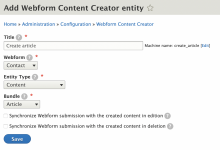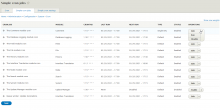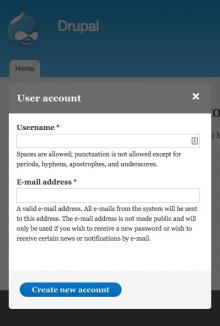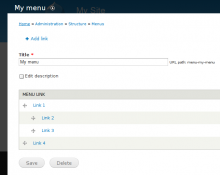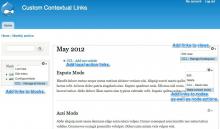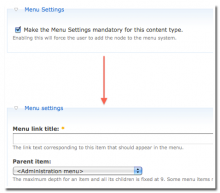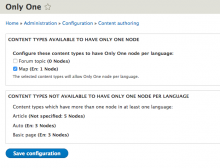Add functionality and customize your Drupal application with thousands of projects contributed by our amazing community.
A module is code that extends Drupal's by altering existing functionality or adding new features. You can use modules contributed by others or create your own. Learn more about creating and using Drupal modules.
This module provides the ability to create content entities after submitting webforms, and to have mappings between the fields of the created content entity and webform submission
Create separate pages for different view modes for a given content type.
8.x - Configuration
- Go to your drupal admin -> "Configuration" -> "Search and metadata" -> "Entity view mode path".
- Here you can add a path pattern (e.g. /%/summary) and select a view_mode (e.g. teaser).
7.x - Configuration
- Create a content type
- Configure a view mode. If you are using Display Suite, or another means of adding view modes, you may need to add a new one.
- Go to the "manage display" tab for your content type.
- In the "View mode pages" tab, enter your URL pattern for the view mode page.
Configuration Synchronizer provides methods for safely importing site configuration from updated modules, themes, or distributions.
This is a simple module that enables site builders to use the built-in Overlay for non-admin pages.
The plug-and-play recurring events and registration system for Drupal.
The Akamai modules provides integration with the Akamai Content Control Utility (CCU) Web Service.
Replicate Paragraphs Extends Replicate module to manage the cloning of paragraphs_item entities and fields.
Basics
The Simple Cron is a light-weight module for cron job management.
This module allows fields to be required only when the piece of content is being published or is already published. This can be used when you have fields such as tags or SEO information on
Dialog provides an API for opening content in an interactive overlay.
Dialog is a backport of the Drupal 8 Dialog API for JavaScript.
This module confirms that a newly entered email can be received by the user.
This module simplifies the core Menu and Shortcut modules by merging the "List links" and "Edit menu" operations into a single administration page.
The field inheritance module can be considered to be a field-level entity reference alternative. It allows site administrators to inherit any field from any entity into any other entity.
This module improves on core's "Empty Node Frontpage behavior" area plugin (used in headers and footers) when used on views that show a restrictive set of content types (e.g.
Htaccess is a module which autogenerates a Drupal root htaccess file based on your settings.
Drupal tries to provide a one size fits all htaccess for Apache webservers, but this goal is increasingly difficult. This module allows the webmaster to set specific options.
Does your client want to modify the header, footer, title, or empty text of a view, but you don't want to train them on the rather intimidating Views UI admin interface or give them access to pages
The Custom Contextual Links module allows you to add your own links to the contextual drop down widgets of blocks and nodes.
Contextual links are really great for quick access to settings pages within your Drupal install. They cut down the time required to click through the sometimes cumbersome Drupal administrative navigation. However, the links displayed in the contextual widget need to be defined through a module. This is where CCL comes in. This module allows you to add and manage custom links through a UI that will be displayed in the contextual widgets.
You can add contextual links to:
- a single node
- all nodes of a content type
- all nodes
- a specific block
- all blocks
- all views
- all displays of a specific view
- all specific display of a view
Node action links support so far:
- make a node sticky/unsticky
- publish/unpublish a node
- Promote/remove a node from the home page
Local action links can be assigned to pages with a similar interface like core blocks. The visibility can be controlled by:
- path
- content type
- user role
This module is a drop-in replacement for syslog. It allows more flexibility with settings.
This module enables you to make the Menu Settings required on specific content types.
The module allows to ignore certain configurations owned by modules enabled in configuration splits during export and import.
SUMMARY
We have a simple mission here at Lumturio; stopping your site from getting hacked.
Looking at every aspect of all of your sites, from necessary upgrades and vulnerabilities, to individual modules. Presenting it in one, easy to read dashboard.
No bullshit, just a simple UI with all the information you need to stay secure.
We allow administrators to build their own monitoring interface to check on multiple installations at once.
Entity Share Cron allows configuring content to be automatically synchronized with another Drupal site on Cron runs.
The Allow a content type only once module allows the creation of Only One node per language in the selected content types for this configuration.
Pages
 Support for Drupal 7 is ending on 5 January 2025—it’s time to migrate to Drupal 10! Learn about the many benefits of Drupal 10 and find migration tools in our resource center.
Support for Drupal 7 is ending on 5 January 2025—it’s time to migrate to Drupal 10! Learn about the many benefits of Drupal 10 and find migration tools in our resource center.